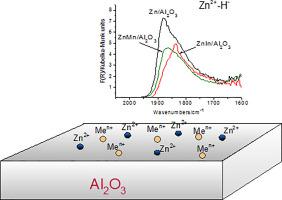当前位置:
X-MOL 学术
›
Mol. Catal.
›
论文详情
Our official English website, www.x-mol.net, welcomes your feedback! (Note: you will need to create a separate account there.)
The impact of indium and manganese modifiers on the catalytic properties of zinc-alumina propane dehydrogenation catalysts
Molecular Catalysis ( IF 4.6 ) Pub Date : 2024-04-05 , DOI: 10.1016/j.mcat.2024.114104 Yury A. Agafonov , Alexander I. Serykh
Molecular Catalysis ( IF 4.6 ) Pub Date : 2024-04-05 , DOI: 10.1016/j.mcat.2024.114104 Yury A. Agafonov , Alexander I. Serykh

|
Supported zinc-containing catalysts are considered as a viable alternative to the currently-deployed Cr-based (toxic) and Pt-based (costly) catalysts of alkane dehydrogenation, as reflected also in the increased number of reports related to the Zn-based catalysts in recent years. Here, we present a study of alumina-supported Zn-In and Zn-Mn propane dehydrogenation (PDH) catalysts prepared by the tailored methods. Specifically, the introduction of zinc relied on the chemical vapor deposition (CVD, using Zn vapor) onto alumina or alumina-supported indium or manganese materials, the latter two prepared by the impregnation of alumina with aqueous solutions of the respective metal nitrates followed by the calcination and hydrogen treatment. Alternatively, both zinc and indium were introduced by the co-impregnation of alumina with aqueous zinc and indium nitrates. The PDH tests revealed that the “dilution” of the active Zn surface sites with In cations lead to a significant improvement in the catalytic performance, i.e., the introduction of In increased propene selectivity and attenuated the undesirable cracking and hydrogenolysis side reactions as well as decreased coke formation. In contrast, Mn cations improved the catalytic properties of Zn surface sites to a lesser extent than In cations. All prepared catalysts were characterized by DRIFT (diffuse reflectance infrared Fourier transform) spectroscopy of the adsorbed CO and H probe molecules. It was found that surface In and Mn cations affect Zn sites (electronic and geometric effect), which can be assessed from the position of the IR bands of zinc hydridespecies, formed due to the heterolytic hydrogen dissociation on the Zn active sites. The effect of In and Mn dopants also was confirmed by the molecular DFT simulation.
中文翻译:

铟、锰改性剂对锌铝丙烷脱氢催化剂催化性能的影响
负载型含锌催化剂被认为是目前使用的烷烃脱氢的铬基(有毒)和铂基(昂贵)催化剂的可行替代品,这也反映在与锌基催化剂相关的报告数量的增加最近几年。在这里,我们研究了通过定制方法制备的氧化铝负载的 Zn-In 和 Zn-Mn 丙烷脱氢 (PDH) 催化剂。具体来说,锌的引入依赖于化学气相沉积(CVD,使用锌蒸气)到氧化铝或氧化铝负载的铟或锰材料上,后两种材料是通过用各自的金属硝酸盐的水溶液浸渍氧化铝制备的,然后通过煅烧和氢气处理。或者,通过将氧化铝与硝酸锌和硝酸铟水溶液共浸渍来引入锌和铟。 PDH测试表明,In阳离子对活性Zn表面位点的“稀释”导致催化性能显着提高,即In的引入提高了丙烯选择性,减弱了不希望的裂化和氢解副反应,并降低了催化性能。焦炭形成。相反,Mn 阳离子对 Zn 表面位点催化性能的改善程度小于 In 阳离子。所有制备的催化剂均通过吸附的 CO 和 H 探针分子的 DRIFT(漫反射红外傅里叶变换)光谱进行表征。研究发现,表面 In 和 Mn 阳离子会影响 Zn 位点(电子效应和几何效应),这可以从由于 Zn 活性位点上异解氢解离而形成的氢化锌物种的红外带位置来评估。分子 DFT 模拟也证实了 In 和 Mn 掺杂剂的影响。
更新日期:2024-04-05
中文翻译:

铟、锰改性剂对锌铝丙烷脱氢催化剂催化性能的影响
负载型含锌催化剂被认为是目前使用的烷烃脱氢的铬基(有毒)和铂基(昂贵)催化剂的可行替代品,这也反映在与锌基催化剂相关的报告数量的增加最近几年。在这里,我们研究了通过定制方法制备的氧化铝负载的 Zn-In 和 Zn-Mn 丙烷脱氢 (PDH) 催化剂。具体来说,锌的引入依赖于化学气相沉积(CVD,使用锌蒸气)到氧化铝或氧化铝负载的铟或锰材料上,后两种材料是通过用各自的金属硝酸盐的水溶液浸渍氧化铝制备的,然后通过煅烧和氢气处理。或者,通过将氧化铝与硝酸锌和硝酸铟水溶液共浸渍来引入锌和铟。 PDH测试表明,In阳离子对活性Zn表面位点的“稀释”导致催化性能显着提高,即In的引入提高了丙烯选择性,减弱了不希望的裂化和氢解副反应,并降低了催化性能。焦炭形成。相反,Mn 阳离子对 Zn 表面位点催化性能的改善程度小于 In 阳离子。所有制备的催化剂均通过吸附的 CO 和 H 探针分子的 DRIFT(漫反射红外傅里叶变换)光谱进行表征。研究发现,表面 In 和 Mn 阳离子会影响 Zn 位点(电子效应和几何效应),这可以从由于 Zn 活性位点上异解氢解离而形成的氢化锌物种的红外带位置来评估。分子 DFT 模拟也证实了 In 和 Mn 掺杂剂的影响。



























 京公网安备 11010802027423号
京公网安备 11010802027423号